LAU FAMILY HUNG GAR KUEN LINEAGE
Si-Fu” Wayne Husbands is the owner and chief trainer at The Reading School of Martial Arts
Wayne (Si-Fu) was born on May 18,1967 in Barbados West Indies. At a tender age of ten he always showed a keen interest in the martial arts from the early days of watching the television series of kung fu (Caine) Starring David Carradine. At the age of fourteen Si-fu Wayne Husbands emigrated to England in 1982 where he is currently residing at Reading Berkshire. After a year in the UK in 1983 he was introduced to the Northern Shaolin Eagle claw 北少林鷹爪 which he studied under grand masters and masters along with their students for over 8 years. Prior to this Si-fu Wayne Husbands participated in water boxing style for just over one year. In 1994 his love for the martial arts blossomed with his involvement in the Lau family Eagle claw under the tutelage of several outstanding masters. He became highly skilled in the Eagle claw techniques. At this time, he had added the internal arts of Tai Chi chuan 太極拳, Ba Chi chuan 八極拳 and xing yi chuan 形意拳 to his acquired skills. In 2001 he commenced training in the Lau family Hung gar kung fu under the keen eyes of Master Mark Houghton who played a pivotal role in his development in the Hung gar style. This is the form in which he has become more proficient and enjoys teaching tremendously at present. He is also promoting the Lau family Hung gar kung fu in Reading Berkshire of England, Italy and in Barbados West Indies and hoping to do so in other countries around the world.
LAU FAMILY HUNG GAR KUEN LINEAGE

Gee Seen Sim See or "' Monk Zhi Shan"' is said to have been one of the legendary Five Elders, survivors of the destruction of the Shaolin Temple by the Qing Dynasty (1644–1912). He is linked to many southern Chinese martial arts including the five major family styles of Hung Gar Kuen, Lau Gar Kuen, Choy Gar Kuen, Lee Gar Kuen and Mok Gar Kuen.
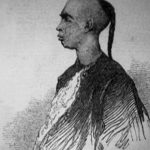
Hung Hei-gun or Hong Xiguan (1745—1825) was a Chinese martial artist who lived in the Qing dynasty. He was also an influential figure in the Southern Shaolin school of Chinese martial arts.
Hung was originally a tea merchant. He escaped to the Southern Shaolin Monastery in Fujian Province after having an argument with Manchus elites. The abbot, Reverend Gee Seen Sim See, accepted him into the monastery and soon found out how talented and hardworking he was in Southern Shaolin martial arts. Gee Seen Sim See was impressed by these qualities and soon began to teach Hung the Black Tiger Fist that he specialised in. After six years, Hung became the best among the "lay" members of Southern Shaolin Monastery. These "lay" members refer to people who learnt Southern Shaolin martial arts but were not ordained as monks in the monastery. However, Qing government forces destroyed Southern Shaolin Monastery later because the monastery provided refuge for many rebels seeking to overthrow the Qing dynasty.
Hung had two notable students: Luk Ah-choi (陸阿采; Lu A'cai) and Lei Jou-fan (李祖寬; Li Zukuan). Luk learnt Southern Shaolin martial arts from both Hung and Hung's master, Reverend Gee Seen Sim See . He founded the Hung Gar (洪家) style of martial arts, which he named after the Hung-mun (洪門), a Chinese fratenal organisation that was associated with the anti-Qing revolutionary movement.
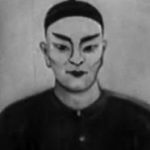
Luk Ah Choy was a well known disciple of the Abbot Gee Sin Sim See and classmate of Hung Hei Goon. Luk Ah Choy was unique because unlike other Hung Gar masters, he was of Manchurian descent. He is credited for his efforts to spread the art of Hung Gar Kuen. Luk Ah Choy started his Kung Fu training as a young boy under a monk named Li Bakfu who taught him a Northern style of Kung Fu called Fa Kuen (Flower Fist).
He later trained under Gee Sin and became one his top disciples. Upon hearing of his student’s school, Gee Sin sent Luk Ah Choy to Fa city to further develop his skills under Hung Hei Goon. Hung Hei Goon passed all his skills on to Luk Ah Choy including the famous Tiger Crane form he had developed. He was later sent to Canton by Hung Hei Goon to help and spread the art of Hung Gar. It was later that Luk Ah Choy opened his own school in Canton teaching Hung Gar Kuen openly to the public.
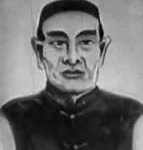
Wong Kei-ying or Huang Qiying (ca. 1815–1886) was a Chinese martial artist and physician who lived in the Qing dynasty. He was one of the Ten Tigers of Canton. His son, Wong Fei-hung, who inherited his martial arts and medical skills, is commonly portrayed as a folk hero in Chinese popular culture.
Wong was born in Xiluzhou Village, Xiqiao Ridge, Nanhai County, Guangzhou Prefecture, Guangdong Province, which is now part of Xiqiao Town, Nanhai District, Foshan City, during the reign of the Jiaqing Emperor. His date of birth is not known. Since his son, Wong Fei-hung, lived from 1847 to 1924, his year of birth was estimated to be between 1810 and 1820.
In his younger days, Wong earned a living by performing martial arts and acrobatics in the streets. One day, he encountered Luk Ah-choi (陸阿采; Lu A'cai), a notable practitioner of the martial art Hung Gar. Luk was also a student of Reverend Gee Seen Sim See, one of the legendary Five Elders who survived the destruction of Shaolin Monastery by the Qing government in the 17th or 18th century. Luk saw great potential in the young Wong, accepted him as an apprentice, and taught him martial arts. Another legend, which reflects historicity in the Hung Gar lineage, says that Wong learnt martial arts from his father, Wong Tai (黃泰; ca. 1782–1867), who was taught by Luk Ah-choi. Wong spent ten years training and mastering all the skills he learnt, including the Single Hard Fist, Double Hard Fist, Taming the Tiger Fist, Mother and Son Butterfly Knives, Angry Tiger Fist, Fifth Brother Eight Trigram Pole, Flying Hook, and Black Tiger Fist. Once his training was complete, Wong joined the Black Flag Army and became its martial arts instructor. However, as his wages were too low, he also opened a herbal medicine dispensary, Po Chi Lam (寶芝林), to earn additional income to support his family. Wong was named one of the Ten Tigers of Canton, a group of the ten most famous martial artists in Guangzhou (Canton) in the 19th century. His martial arts and medical skills were inherited by his son, Wong Fei-hung, who also became a famous martial artist and physician in his own right.
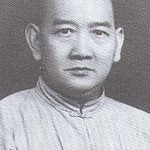
Wong Fei-hung or Huang Feihong (9 July 1847 — 25 March 1924) was a Chinese martial artist, physician, and folk hero, who has become the subject of numerous martial arts films and television series. He was considered an expert in the Hung Gar style of Chinese martial arts. As a physician, Wong practised and taught acupuncture and other forms of traditional Chinese medicine in Po Chi Lam (宝芝林; 寶芝林; Bǎozhīlín; Bou2-zi1-lam4), a medical clinic in Guangzhou City, Guangdong Province. A museum dedicated to him was built in his birthplace in Foshan City, Guangdong Province.
Wong was born in Foshan Town, which is now part of Zumiao Subdistrict in Chancheng District, Foshan City, Guangdong Province, during the reign of the Daoguang Emperor in the Qing dynasty. His ancestral home was in Xiluzhou Village, Xiqiao Ridge, Nanhai County, Guangzhou Prefecture, Guangdong Province, which is now part of Xiqiao Town, Nanhai District, Foshan City.
At the age of five, Wong started learning Hung Gar from his father, Wong Kei-ying. He often accompanied his father on trips from Foshan to Guangzhou, the provincial capital of Guangdong Province, where his father peddled medicine and performed martial arts in the streets. When he was 13, he encountered Lam Fuk-sing (林福成; Lin Fucheng), an apprentice of "Iron Bridge Three" Leung Kwan, in Douchi Street in Foshan Town. Lam taught him how to use the sling and the essential moves of the martial art Iron Wire Fist. In 1863, Wong started a martial arts school in Shuijiao (水腳) in Xiguan, which is now part of Liwan District, Guangzhou City. His students were mainly metal labourers and street vendors. In 1886, Wong opened his family's medical clinic, Po Chi Lam (寶芝林; Baozhilin), in Ren'an (仁安), which is now part of Xiaobei Road, Yuexiu District, Guangzhou City. In legend, around the 1860s or 1870s, Wong was recruited by Liu Yongfu, the commander of the Black Flag Army, to be the medical officer and martial arts instructor for the regular soldiers and the local militia in Guangzhou. He also followed the Black Flag Army to fight the Imperial Japanese Army during the Japanese invasion of Taiwan in 1895.
In 1912, the Republic of China was established following the collapse of the Qing dynasty. During the chaotic early years of the Republican era, many businessmen who operated places of entertainment in Guangzhou decided to hire guards (or bouncers) to protect their businesses on-site in case trouble broke out. As Wong was trained in martial arts, he was hired by various businesses to be one of such guards.
In 1919, when the Chin Woo Athletic Association opened a branch in Guangzhou, Wong was invited to perform at the opening ceremony. In the same year, Wong Hon-sam, one of Wong's sons, who was working as a bodyguard in Wuzhou City, Guangxi Province, was murdered by a rival known as "Devil Eye" Leung (鬼眼梁), who was apparently jealous that Wong Hon-sam was better than him in martial arts. Wong was so affected by this incident that he stopped teaching his other sons martial arts.
Around August–October 1924, Wong's medical clinic, Po Chi Lam, was destroyed when forces of the Republic of China's Nationalist government were suppressing an uprising by the Guangzhou Merchant Volunteers Corps. Wong felt so dejected and saddened by the loss of Po Chi Lam that he fell into depression and became ill. He died from illness in Fangbian Hospital (方便醫院), which is now the Guangzhou First People's Hospital at Panfu Road in Guangzhou's Yuexiu District, and was buried at the foot of Baiyun Mountain. Wong's wife, Mok Kwai-lan, and his sons, along with his students Lam Sai-wing and Dang Sai-king (鄧世瓊; Deng Shiqiong), moved to Hong Kong and opened martial arts schools there.

Lam Sai-wing ( 林世榮) (1861 – 1942), was a student of the Cantonese martial artist, healer and folk hero Wong Fei-hung. Lam was born in Nanhai district, Guangdong. He followed the customs of his ancestors and learned the traditional martial arts of his family, progressing to learning from Lin Fucheng, Wong Fei-hung and Wu Quanmei. He was eventually considered an expert in Hung Gar Kuen ("Hung family fist", a style originating from the Southern Shaolin Tiger style, known for its efficiency and widespread at the time in various secret societies), and may have also studied Fut Kuen ("Buddhist Fist", a style practiced by various Buddhist sects in Guangdong province).
He founded the Wu Ben Tang (Hall of Fundamental Study) in Guangzhou (Canton) where he taught his martial arts.
Towards the end of the Qing dynasty, Lam gained first place at a large martial arts competition that took place at the Dongjiao ground, receiving a silver medal from Sun Yat-sen as a token of recognition for his service and success.
Between 1917 and 1923, Lam served in the National Revolutionary Army of Fujian province as Chief Instructor in hand-to-hand combat.
Lam eventually moved to Hong Kong, where he started teaching martial arts. Together with his favorite students Zhu Yuzhai, Zhang Shibiao, Li Shihui, and others, he wrote three books on the three primary forms (taolu) of Hung Gar Kuen: gung ji fuk fu keun ("Taming the Tiger Fist"), fu hok seung ying keun ("Tiger Crane Paired Form Fist"), and tit sin keun ("Iron Wire Fist").
Lam and his students, which are said to have numbered over 10,000 during his life, are primarily responsible for popularizing the style in the 20th century. Some of his students became among the first actors and stunt people in the fledgling Hong Kong "kung fu" film industry in the 1940s. They included two men who would work as action directors on the Wong Fei-hung films that starred Kwan Tak-hing - Leong Wing-hang and Lau Jaam, father of action director and star, Lau Kar-leung. Another student of Lam was Golden Harvest producer Raymond Chow.
Although his exact age is not known, Lam was over 80 when he died during the Japanese occupation of Hong Kong.
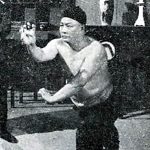
Cantonese martial art Master Mr.Wong Fei Hung (黃飛洪), among his inheritors, there were two famous names, one being Leung Fun (梁寛), and the next was Mr. Lau Jaam (劉湛). They both as known-brave and skillful in fighting, outstanding in the Wong Fei hung method of Hung Gar. Lau Jaam was a student of Lam Sai Wing (林世榮). Lau Jaam following the instruction of Lam Sai Wing taught the Lau Gar Hung Kuen adding his own emphasis on certain skills. The Lau Gar Hung Kuen Art was passed down through his family to his son Lau Kar Leung.

Lau Kar-leung (28 July 1934 – 25 June 2013), also known as Liu Chia-liang, was a Hong Kong-based Chinese actor, filmmaker, choreographer and martial artist. Lau is best known for the films he made in the 1970s and 1980s for the Shaw Brothers Studio. One of his most famous works is The 36th Chamber of Shaolin which starred Gordon Liu, as well as Drunken Master II which starred Jackie Chan. Before becoming famous, Lau worked as an extra and choreographer on black and white Wong Fei-hung movies. He teamed up with fellow Wong Fei-hung choreographer Tong Gaai on the 1963 Hu Peng-directed wuxia film South Dragon, North Phoenix. Their collaboration would continue on until the mid-1970s. His first appearance in a film was in Brave Lad of Guangong (1950).[1] In the 1960s he became one of Shaw Brothers' main choreographers and had a strong working relationship with director Chang Cheh, working on many of Chang's films as a choreographer (often alongside Tong Gaai) including The One-Armed Swordsman, as well as other Shaw Brothers wuxia films, such as The Jade Bow. After a split with Chang on the set of Marco Polo, Lau evolved into a director during the sudden boom of martial arts films in the early 1970s. He occasionally did choreography work for non-Shaw films as well, such as Master of the Flying Guillotine. After Shaw Brothers collapsed in the 1980s, Lau moved on and continued directing and choreographing films, among them Drunken Master II. However, the film's star Jackie Chan and director Lau clashed over the style of fighting, resulting in Lau leaving the set before the shooting of the final fight scene, which was then taken over by Chan.[2] Most recently, Lau performed acting and choreography work for Tsui Hark's 2005 film Seven Swords. Mark Houghton opened the Lau Family Hung Kuen school Lau Family Hung Gar academy in Hong Kong / Fanling with the support of his sifu, Lau. He gave his disciple the permission to spread the art of Lau Family Hung Kuen to chosen students. There are already branches in England, France, Austria, China, Singapore and Malaysia .

Mark Houghton is a Disciple of the famous Lau Kar Leung in the Lau Family Hung Gar Kuen style. Mark met Lau Kar Leung in Hong Kong whilst working as a bodyguard for a Malaysian client.
Mark had always been an admirer of Lau Kar Leung and this was his inspiration to learn Kung Fu. Whilst in Malaysia Mark had learnt Hung Gar and subsequently began to study with Lau Kar Leung. Mark became a disciple and the lineage holder of Lau Family Hung Kuen. Mark continued to study with Lau Kar Leung until his death in 2013. Through Lau Kar Leung Mark featured as actor and stunt man in many Hong Kong kung fu movies. Mark continues the teachings and legacy of Lau Kar Leung both through teaching Lau Gar Hung Kuen in Hong Kong, China and England as well as running the Lau Gar Ban Stunt Group who train as stunt men for the movies.
Mark has disciples around the world and in the UK Wayne Husband is the representitive of the Lau Gar Hung Kuen.

